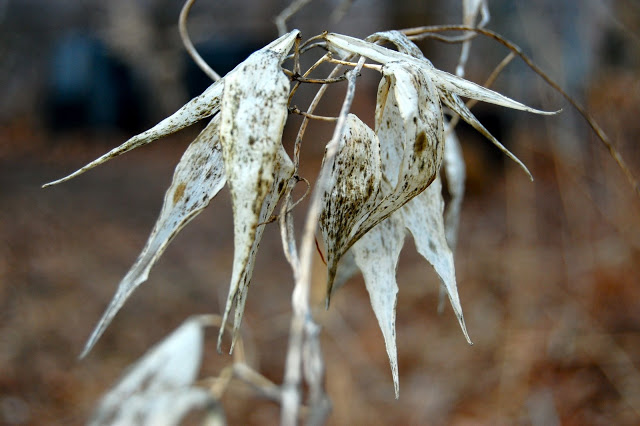Amongst the refuse of last year’s greenery, you might now be noticing the evidence of past crime: the dried pod casings of dog-strangling vine (Vincetoxicum rossicum) [Update: This weed is also known as swallowwort, Cynanchum spp., from the Greek meaning “to choke a dog”)]. In my continuing quest to do my part to eradicate this pernicious weed, last May I wrote this post about t
he problem. [Read about the eradication efforts in Ottawa’s Fletcher Wildlife Garden here.]
Now
buy addyi online azpsych.org/general/october/html/addyi.html no prescription pharmacy, when the
buy professional cialis online azpsych.org/general/october/html/professional-cialis.html no prescription pharmacyfoliage is off the shrubs, it’s easy to see where dog-
buy zepbound online cphia2023.com/wp-content/uploads/2024/08/jpg/zepbound.html no prescription pharmacystrangling vine has taken a foothold. Each of the pointy pods was once full of fluffy seeds, ready to take root in a green space near you. Meanwhile, the woody root systems are plotting new ways to send up prolific shoots. It isn’t only “dogs” being strangled here. It’s entire ecosystems.
Please, keep your eyes open and your knives sharpened. Cut this one off at the root when you see its snakey little head emerge from beneath your rugosa roses (or fences or hedges).
This plant is trying to take over Toronto. Let’s all tell it to get the heck outta town.
[Edited update from Helen, the whys and how-tos: Haven’t been able to detect why it’s called dog-strangling vine. It’s certainly a tough stem and would be about dog height. Tends also to become a thicket if left unchecked.
Yes, do cut it off just below the soil to starve the root – just hold the stem and cut it at the base with a knife or secateurs, just at or below the soil surface. Don’t yank it up, as the breaks in the root system can send up new shoots.
You’ll probably have to repeat this a few times, as the root will continue to try to send up shoots. Eventually, however, without the green leaves to nourish it, the root will starve and dwindle. (BTW, this is a good way to deal with other strong-rooted weeds, such as dandelions.)]





8 comments
So–does it actually strangle dogs? I’ve never heard of this one! Good luck with the eradication effors.
By the way, I left you a message over at Blotanical–me and a small army. Stop by sometime.
–Kate
Hi Kate. That’s a question for Helen to answer. I wondered about the dog-strangling aspect myself. They sure made evocative names in the olden days! It does form rather a thick mass and I can picture a dog running though it on a walk and maybe getting a bit tangled. Though being actually strangled would be a stretch. But who knows. Helen?
How do you leave messages at Blotanical? I see they have forums, but couldn’t find you.It’s a pretty amazing site.
When I first moved in to my home, I was standing in my garden one day with my elderly neighbour and he was explaining what was a weed and what was a perennial. All of a sudden he vehemently pulled out a weed and since then I’ve discovered it was dog strangling vine. Sadly it popped up in a few places on my property last year. So instead of pulling it out Sarah, you recommend digging down and cutting it out with a knife?
Haven’t been able to detect why it’s called dog-strangling vine. It’s certainly a tough stem and would be about dog height. Tends also to become a thicket if left unchecked.
Yes, do cut it off just below the soil to starve the root — just hold the stem and cut it at the base, just at or below the soil surface. Don’t yank it up, as the breaks in the root system can send up new shoots.
You’ll probably have to repeat this a few times, as the root will continue to try to send up shoots. Eventually, however, without the green leaves to nourish it, the root will starve and dwindle. (BTW, this is a good way to deal with other strong-rooted weeds, such as dandelions.)
I've read much about this being an invasive species but have not been able to find what country it came form originally.
Any info to satisfy my curiousity?
Anonymous,
It originated in Europe — but has probably naturalized in North America. Here's some more info (you'll have to paste the link into your browser):
http://www.rbg.ca/cbcn/en/projects/invasives/i_shrub2.html
And, further to my comment above, I've noted the origin of the name in subsequent posts on this blog with the tag "weeds" (it comes from the Greek for the alternative genus name for DSV, Cynanchum)
why is it called the Dog-strangling vine?
Hi, Anonymous — As I wrote above, the term comes from one of its names: Cynanchum spp., from the Greek meaning "to choke a dog").
The vines themselves are quite fibrous when in the growth stage. Plus, a well-established clump can twine up any handy support (tree, shrub, other plants, fences) into a thicket of stems. My guess is that a dog would find it difficult to penetrate.
Another possibility for the name might be the seed pods. This plant is a cousin of milkweed, with seed pods that explode into a mass of silky, wind-borne seeds. A dog biting into the pod might find this explosion in the mouth or throat highly unpleasant.
These are just guesses on my part.